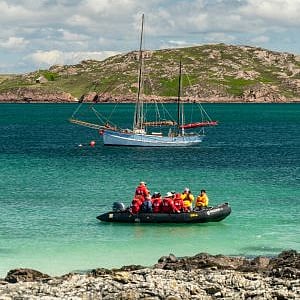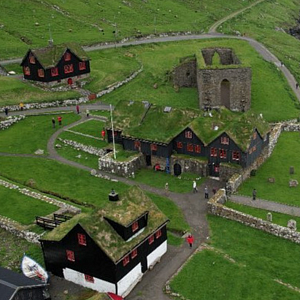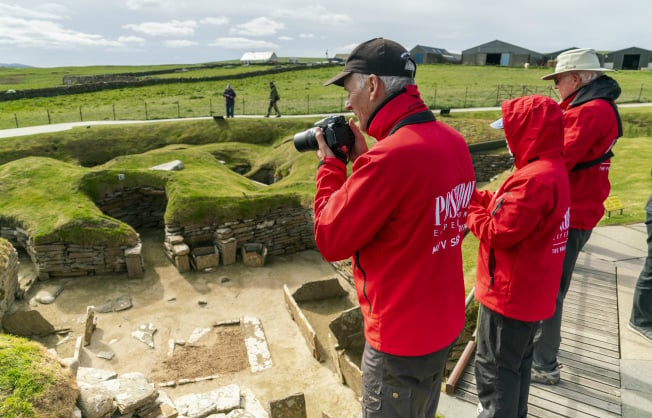All about Faroe Islands cruises
What makes islands so special? Their isolation, remoteness, nature, heritage and wildlife are usually preserved and shielded from the busy life of mainlanders. Our small expedition ship and Zodiac boats will give you the chance to explore off the beaten path and discover otherwise inaccessible gems. We combine the best of the British Isles with the rich history and stunning landscapes of the Faroe Islands on our cruises. Our onboard specialists will guide you through diverse birdlife, help you improve your photography skills and show you this region from an angle few people have seen it from ever before.
…a glimpse of what awaits you on our cruises:
-
Neolithic and historic Viking sites on the British Isles
-
Deep green hills, charming turf roof houses and puffin colonies on the Faroes
-
An abundance of birdlife: a dream-come-true for any bird lover
-
Zodiac cruising: remote bays, landings off the beaten path and prime wildlife watching
-
Jan Mayen Island and the northernmost active volcano, Beerenberg
-
Crossing the Arctic Circle
- Dramatic glaciers, fjords and polar bears on the Svalbard archipelago
What you can see on the Faroes
Fairytale landscapes. You’ll witness deep green hills with steep cliffs and the bright-blue ocean – it’s a combination that amazes even the most avid traveler. There are no native trees on the island due to strong winds. The few trees you find there were introduced from places with similar climates, such as Alaska and Tierra del Fuego.
Grass roof houses. Admire a 1000-year-old+ building style that shields you from rain and offers thermal insulation. You can see these charming houses in the Faroese capital of Tórshavn. And did you know that you can also see them in Iceland?
Puffin colonies. Spot these colorful and cute birds along the Faroese coastline where they gather in large colonies on the grassy slopes.
Expeditions to the Faroe Islands
Itinerary
There’s plenty to discover! We’ll have prime access to remote bays, allowing you to encounter the unspoiled nature of the Artic thanks to our small expedition ship, the Sea Spirit. Choose the itinerary that matches your adventurous spirit!.
Wild Islands & Lands of Legends (British Isles & Faroes)
Board this unforgettable cruise in Edinburgh. Over the course of 12 days, you’ll explore the best of history, nature and wildlife. Discover Neolithic villages, the famous St. Magnus Cathedral and the Ring of Brodgar on the Orkney Islands. See the rugged coastlines, picturesque lighthouses and an abundance of seabirds on Fair Isle. Visit the unspoiled beauty of the Faroe Islands with their deep-green hills, blue sea and charming villages. And for our bird lovers: the Faroes are home to many rare seabirds such as the adorable puffin!
From the Highlands to the High Arctic (Crossing the Arctic Circle, Jan Mayen & Svalbard)
Board your expedition in Edinburgh and head north to the Orkneys, Fair Isle and the Shetland Islands. Continue to the Faroe Islands where fairytale landscapes and charming villages with turf roof houses await you. Cross the Arctic Circle and continue to Svalbard with its magnificent glaciers, flowering tundra and prime opportunities to spot polar bears. We’ll also stop at the remote and wild island of Jan Mayen, featuring the northernmost subaerial active volcano on the planet (Beerenberg).
Activities
Birdwatching
Grab your binoculars and prepare yourself for birdlife galore! The British Isles and Faroe Islands are the perfect place for birders. We’ll visit Europe’s prime destination to see rare seabirds like northern fulmars, kittiwakes, skuas and puffins. Fair Isle alone hosts over 345 bird species! Whether you’re a birder or a photographer, we know how to get you close to the action. Our large open deck aboard the Sea Spirit is perfect for spotting wildlife. Small motorized Zodiac boats take you even closer to secluded bays and cliffs and you’ll also get plenty of time to explore ashore.
Zodiac Cruising
While you get prime vistas from aboard, nothing compares to jumping into one of our small motorized Zodiac boats. Cruise pristine waters and visit the most remote and secluded bays. With Zodiacs, we’ll be able to land on beaches that are otherwise inaccessible to visitors. Our expedition guides will show you the gems of the area that you would otherwise not be able to see.
Historic Exploring
Combine history with unspoiled nature on the British Isles and Faroes. This region is a special treat for fans of Viking culture. Explore the St. Magnus Сathedral on the Orkney Islands, founded by Viking Earl Rognvald in 1137 to commemorate his late uncle St. Magnus the Martyr. Viking culture comes to life on the Faroe Islands, where the locals proudly celebrate their Viking heritage. While the very first settlers (around the 6th century AD) were Irish monks, Vikings came at around 800 AD to settle on the Faroes and excavations of Viking Age farmhouses (longhouses) support this.
Plan your tour
How to get to the Faroes
Our cruises to the Faroe Islands and British Isles set sail from Edinburgh in Scotland. We recommend you book airfare ahead of time.
Visa control
If you are an EU or EAA citizen, you can visit the Faroe Islands without a visa. For all other countries, we recommend to check in advance if a visa is required. Let us know if you need assistance, we’ll be glad to help.
Cruise Ships
We deliver only a high-class fleet for each Faroe Island Cruise. We rely on our small but advantageous ship.
The deluxe expedition ship Sea Spirit is very maneuverable and contains 114 passengers. Comfortable accommodation on board and an additional fleet of Zodiacs make this vessel very attractive.
On our ship, we offer many different onboard entertaining options: restaurants, bars, lounge, library, gym, etc. You will never get bored. Besides, due to low passenger groups going ashore during stops is very pleasant.
When to go on a Faroe Islands cruise?
Summer is the best time to visit! Temperatures from May to September will range around 9-13 °C (48-55 °F). We set sail for the islands from May to June.
Facts about the Faroes
Not quite Denmark…
Similar to Greenland, the Faroes are a self-governing overseas division of Denmark. This lets the Faroe Islands govern and legislate a wide range of areas independently. They are not part of the European Union.
A lot of islands…
With 18 main, and a total of over 750 islands, they cover 1,400 km2 (540 square miles). You’ll find the capital Tórshavn
on the island of Streymoy (the largest and most populated island of the archipelago). The Faroes are located in the North Atlantic, roughly 580km (360 miles) off the coast of Norway and 430km (270 miles) from Iceland.
Let the sheep take over…
Did you know that with roughly 70,000 sheep on the islands, they outnumber the human population? In 2022, only 53,090 people officially resided on the Faroes.
Fish & Tourists…
The two main industries on the islands are fishing (accounting for 97% of all exports) and tourism. Since 2019, the Faroes closed for tourists annually for a duration of 2 days (usually in April). Most of the attractions are closed then, but you are still welcome as a volunteer to help with maintenance and clean up!
Say it in Faroese…
The Faroes have their own official language: Faroese. It’s closely related to Icelandic, Norwegian, Danish and Swedish, and local people regard preserving their language as a crucial part of their national culture. Visit Olav’s Festival (July 29th) to dive into the local culture with celebrations, folk music, art exhibitions, concerts and dancing, and see the locals out and about in their beautiful traditional dresses!
FAQ
What’s the weather like on the Faroe Islands?
We sail to the Faroe Islands in May, so the average temperature will be around 9 °C (48 °F). Rain and strong winds are common on the islands.
What should I wear during a trip to Faroe Islands?
We recommend you pack warm clothes and dress in layers. Rain and strong wings can prevail on the islands throughout the year, so rain- and wind-proof gear is essential.
Can you see the Northern Lights on the Faroe Islands?
Yes, but it depends on your luck and the time of the year. The best time to spot them on the Faroes is from September through April.






